Sesame Ginger Beef Rice Stack: A Delicious and Easy Weeknight Delight
The Sesame Ginger Beef Rice Stack is a flavorful journey into the heart of Asian-inspired cooking. This dish captures the essence of savory sesame oil, the zing of fresh ginger, and the richness of tender beef, all elegantly layered over a bed of fragrant rice. Perfect as a comforting dinner after a long day, it combines texture and aroma in an unforgettable way.
Each bite of the Sesame Ginger Beef Rice Stack introduces a symphony of flavors, from the deep umami of soy sauce to the subtle sweetness of honey and garlic. The beef, sliced thin and cooked to perfection, provides a tender yet hearty contrast to the fluffy rice beneath. Finishing with a sprinkle of toasted sesame seeds elevates the dish, offering both visual appeal and a crunchy texture.
Quick Recipe Highlights
Flavor Profile: The Sesame Ginger Beef Rice Stack is a balance of sweet and savory notes. The soy sauce brings a rich, salty depth, while ginger and sesame create a warming sweetness.
Texture: This dish plays with contrasts—tender beef, crisp green onions, and smooth sauce, all atop soft white rice. Each layer offers a different mouthfeel.
Aroma: The aromatic notes from ginger and garlic will fill your kitchen, complemented by the tantalizing scent of sesame oil and soy sauce.
Visual Appeal: Visually, the Sesame Ginger Beef Rice Stack is a stunning dish. The glossy, dark sauce-coated beef contrasts beautifully against the white rice, all garnished with vibrant green onions and sesame seeds.
Skill Level Needed: This recipe is suited for cooks of all levels. Simple slicing and basic pan-searing are the primary techniques, requiring minimal experience.
Special Equipment: A sharp knife for thinly slicing beef, a non-stick skillet for even cooking, and a reliable rice cooker ensure each component is perfectly prepared.
Recipe Overview
Difficulty Level: The Sesame Ginger Beef Rice Stack is classified as easy due to its straightforward preparation steps and accessible ingredients. Even novice cooks will find success with clear instructions.
Category: This dish can be categorized as a main course, perfect for both lunch and dinner. It combines protein and carbohydrates, making it a satisfying standalone meal.
Cuisine: Drawing from Asian culinary traditions, this recipe is influenced by Chinese and Japanese flavors. It showcases the harmonious balance typical of these cuisines.
Cost: This meal is budget-friendly, with most ingredients being pantry staples. Beef can be adjusted to meet budgetary needs, making it affordable.
Season: Ideal for any season, this dish can be enjoyed year-round. It’s warming during cooler months and refreshingly light for summer dining.
Occasion: Whether a family dinner or casual entertaining, this recipe suits several occasions. Its beautiful presentation makes it a dinner party star.
Why You’ll Love This Recipe
The Sesame Ginger Beef Rice Stack captivates with its delightful taste and texture. The savory marinade coats the beef, ensuring each bite is bursting with flavor, while the fluffy rice absorbs the rich sauce. Paired with the crunchiness of toasted sesame seeds, this dish is a textural delight.
Convenience in preparation is another winning factor. Using only one pan for the beef minimizes clean-up, and the rice cooker does most of the work for you. Ready in just 35 minutes, it’s ideal for busy weeknights without sacrificing quality or flavor.
Nutritionally, this recipe offers a balanced meal. Lean beef provides protein, rice supplies energized carbohydrates, and the addition of greens like onions and sesame seeds offers vitamins and healthy fats, making it a wholesome choice.
Socially, the dish has a wow factor that impresses guests. Its aesthetic presentation with layered colors and garnishes makes it perfect for entertaining. It’s a dish that’s as pleasing to the eye as it is to the palate.
Cost-effectiveness and accessibility of ingredients make this recipe an easy go-to. With simple substitutions available for some components, you can tailor it to suit your budget and what’s in your pantry, proving that gourmet taste doesn’t require extravagant spending.
Historical Background and Cultural Significance
The Sesame Ginger Beef Rice Stack draws from the storied culinary traditions of Asia, particularly China and Japan, where the marriage of soy, ginger, and sesame has been a long-time favorite. Such combinations are prevalent in Asian cuisine and have been passed down through generations, evolving with time.
Culturally, ginger and sesame have been staples in Asian kitchens, valued for both their flavor and health benefits. Ginger is revered for its anti-inflammatory properties, while sesame oil is celebrated for its nutrient-rich profile, becoming essential components of cooking in these regions.
Through the global expansion of Asian cuisine, dishes like the Sesame Ginger Beef Rice Stack have been adapted worldwide, reflecting local interpretations while maintaining traditional flavors. The dish retains the essence of its origins while embracing innovation.
In different regions, variations of this recipe might include diverse aromatics or vegetables, showcasing the flexibility and creative potential inherent in Asian-inspired cooking. Such adaptability ensures its continued relevance across cultural and culinary boundaries.
Ingredient Deep Dive
Beef: In many cultures, beef symbolizes strength and prosperity. In Asia, thinly sliced beef is a common feature in hot pots and stir-fries. Nutritionally, beef provides essential protein, B vitamins, and iron. Selecting marbled cuts ensures tenderness, and storing beef in airtight containers keeps it fresh and flavorful. Substitute with chicken or tofu for dietary preferences.
Ginger: Esteemed in many cultures, particularly in Chinese medicine, ginger is famed for its digestive benefits. It adds warmth and subtle heat to dishes. When selecting ginger, choose firm, smooth-rooted specimens without wrinkles. Store ginger in the refrigerator for longevity, wrapped in a paper towel. Galangal or prepared ginger paste offers alternatives if needed.
Soy Sauce: A cornerstone in Asian kitchens, soy sauce delivers umami depth. Originating in China over 2,500 years ago, its use has spread globally. Opt for low-sodium versions to control salt intake, and store it in a cool, dark place. Tamari or coconut aminos can substitute soy sauce for gluten-free options.
Common Mistakes to Avoid
Avoid over-salting the dish by using regular soy sauce instead of low-sodium, which can overpower other flavors.
Do not cut the beef too thick; it needs to be thinly sliced against the grain for tenderness.
Don’t rush the marinating process—30 minutes minimum ensures the flavors penetrate the beef.
Skipping the preheating of the skillet can result in uneven cooking.
Overcrowding the pan with beef can cause steaming rather than searing, leading to a less desirable texture.
Cooking the garlic and ginger for too long leads to bitterness; they should be just fragrant, not burnt.
Using old sesame oil may yield a rancid taste; always check freshness before use.
Forgetting to rinse rice before cooking can lead to a gummy texture.
Essential Techniques
Mastering the art of searing: Proper pan-searing is crucial for achieving a caramelized exterior and tender interior on beef. Ensure the skillet is hot before adding meat; you should hear a sizzle immediately. Pat the beef dry to promote browning and avoid steaming. The visual cue is a golden brown crust forming within a minute or two.
Pro Tips for Perfect Sesame Ginger Beef Rice Stack
Allow the beef to come to room temperature before cooking to ensure even heat distribution.
Rinse the rice under cold water until the water runs clear to remove excess starch, ensuring fluffy rice.
Marinate the beef ahead of time; overnight marination intensifies flavor absorption.
Toast sesame seeds in a dry skillet for enhanced aroma and crunch before garnishing.
Choose a deeper skillet to prevent oil splatters, ensuring safety and easier cleanup.
Rest the beef for a couple of minutes post-cooking, allowing juices to redistribute, enhancing tenderness.
For an umami boost, incorporate a splash of fish sauce when cooking the beef.
Variations and Adaptations
Regional variations could include the addition of Thai basil or bird’s eye chilies for a piquant twist.
Seasonal adaptations make space for vegetables like bell peppers in summer or bok choy in winter, enhancing the dish’s seasonal freshness.
For a lighter, low-carb option, replace rice with cauliflower rice, adapting to dietary preferences without losing texture.
Infuse the dish with an added dimension by integrating citrus zest in the marinade, such as orange or lime, for a bright twist.
To modify texture, stir in cashew nuts or crushed peanuts, adding a nutty crunch to the rice stack.
For a striking presentation, utilize a ring mold to shape the rice and beef into a neat, restaurant-style tower.
Serving and Presentation Guide
For effective plating, use a wide-rimmed plate allowing room for garnishes. Center the rice stack and spoon beef attractively atop. Garnish with freshly chopped green onions and sprinkle toasted sesame seeds for visual charm.
Add vibrancy with a side of pickled vegetables, enhancing both appearance and flavor contrast. A drizzle of sriracha adds color and spice.
For a contemporary serving touch, layer serving within individual bowls for a popular deconstructed style, highlighting individual ingredients.
Wine and Beverage Pairing
For wine pairings, lighter bodied reds like a Pinot Noir balance well with the umami-rich beef and rice. White wines like Riesling complement the ginger’s warmth and sesame’s subtlety.
Non-alcoholic alternatives include chilled green tea, whose earthy flavor bridges the savory and sweet elements harmoniously. For spicy adaptations, a cucumber-infused water soothes the palate.
For coffee pairings, an after-dinner espresso pairs well with the dessert-like finish of honey notes in the dish. This ensures the meal ends on a balanced, uplifting note.
Temperature considerations should focus on serving wine slightly chilled or at room temperature to enhance the dish’s flavor experience.
Storage and Shelf Life
Store leftovers in an airtight container in the refrigerator, maintaining freshness for up to three days. Ideally, store rice and beef separately to preserve textures. Look for signs of spoilage such as off smells or discoloration.
When reheating, add a splash of water to the rice and beef to prevent dryness. Microwave on medium heat or pan-fry gently until thoroughly heated, maintaining quality.
For extended storage, freeze portions in airtight containers for up to two months. Thaw overnight in the refrigerator before reheating, ensuring even temperature distribution.
Make Ahead Strategies
To streamline meal prep, assemble marinades and slice beef up to a day in advance, infusing optimum flavor while saving time.
Store marinated beef in a sealed bag, refrigerating until ready to cook. Pre-measure ingredients into separate containers for efficient assembly.
Assemble rice stacks just before serving, ensuring freshness and flavor pop, with all components easily reheated as needed.
Scaling Instructions
To halve the recipe, simply adjust ingredients by 50%, keeping proportions consistent to ensure flavor integrity.
Doubling or tripling portions requires larger cooking surfaces and additional batches for even cooking, especially for beef.
Extend cooking times slightly for larger quantities, ensuring evenly distributed heat and consistent doneness without overcooking.
Nutritional Deep Dive
A standard serving of Sesame Ginger Beef Rice Stack provides a balanced macro mix of proteins, carbohydrates, and healthy fats, supporting muscle health, energy levels, and satiety.
Beef offers B vitamins and iron, aiding in maintaining red blood cells and reducing fatigue. Rice fuels muscles and stabilizes blood sugar levels.
Portion control is vital to fit dietary needs, with adjustments in carbohydrate and protein ratios supporting weight management goals while allowing indulgence in flavors.
Dietary Adaptations
For gluten-free needs, substitute tamari for soy sauce. Tamari offers similar umami notes without gluten content, maintaining dish integrity.
Creating a dairy-free version is seamless as this recipe excludes dairy naturally unless modifying accompaniments or sides.
For vegan adaptations, replace beef with marinated tofu or tempeh, maintaining protein intake while aligning with plant-based diets.
Low-carb seekers substitute rice with zucchini noodles or cauliflower rice for a textured, flavorful base without carb overload.
Troubleshooting Guide
If the dish tastes too salty, balance flavors with a touch of honey or a squeeze of citrus, restoring equilibrium to errant seasoning.
Should rice turn out gummy, prioritize rinsing before cooking, testing for fluffiness by reducing water content slightly during preparation.
In case of undercooked beef, ensure a higher initial skillet heat and adequate resting time post-cooking for optimal results.
When sauce lacks depth, consider adjusting ginger or garlic levels, honing in on a personal preference for aromatic intensity, avoiding blandness.
Recipe Success Stories
Readers rave about the adaptability of the Sesame Ginger Beef Rice Stack in personalizing spice levels, seamlessly integrating family-friendly flavor alterations.
One home chef shared success with substituting chicken, citing juicy meat paired perfectly with the staple sauce. Photography submissions capture the vibrant contrast of garnished green onion and golden sesame seeds, capturing recipe appeal.
Suggestions range from incorporating mushrooms or peppers as additional vegetables, met with flavorful acclaim from followers experimenting with variations.
Frequently Asked Questions
Q: Can I prepare the Sesame Ginger Beef Rice Stack in advance?
A: While the dish is best served fresh, preparing components like sliced beef and cooked rice a day ahead can reduce on-the-day prep time without compromising the final flavor profile.
Q: Are there vegan options for this recipe?
A: Absolutely, replace beef with tofu or tempeh, providing a protein-packed, plant-based twist. The marinade needs no adjustment, retaining its bold, flavorful essence perfectly.
Q: How do I add more vegetables to the dish?
A: Jazz up your stack with bell peppers, carrots, or snow peas, sautéed briefly for color and a nutrition boost while enhancing texture with welcome crunch contrasts.
Additional Resources
Explore more about Asian culinary techniques with our Stir-Fry Essentials guide, unraveling the mysteries of the artfully quick pan sear.
Discover related recipes like Sesame Chicken Rice Bowl or Teriyaki Tofu Wrap, perfect companions if you enjoyed the flavors of the Sesame Ginger Beef Rice Stack.
Delve into equipment essentials for every home chef’s kitchen: non-stick skillet selection guides to maximize effective cooking strategies, ensuring success every time.
Print
Sesame Ginger Beef Rice Stack
Description
A savory and aromatic dish that layers marinated beef with fluffy rice and a touch of Asian flair.
Ingredients
For the Crust:
- 1 pound beef sirloin, thinly sliced
- 2 cups cooked jasmine rice
- 2 tablespoons soy sauce
- 1 tablespoon grated ginger
- 2 cloves garlic, minced
- 2 tablespoons sesame oil
- 1 tablespoon honey
- 1 tablespoon sesame seeds
- 2 green onions, chopped
Instructions
1. Prepare the Crust:
- In a bowl, mix soy sauce, ginger, garlic, sesame oil, and honey. Add beef, toss to coat, and marinate for 10 minutes.
- Heat a pan over medium heat and cook the marinated beef until browned, about 5-7 minutes. Remove from heat.
- In serving bowls, layer cooked rice, then top with beef, a sprinkle of sesame seeds, and green onions. Serve hot.
Notes
You can customize the seasonings to taste.




